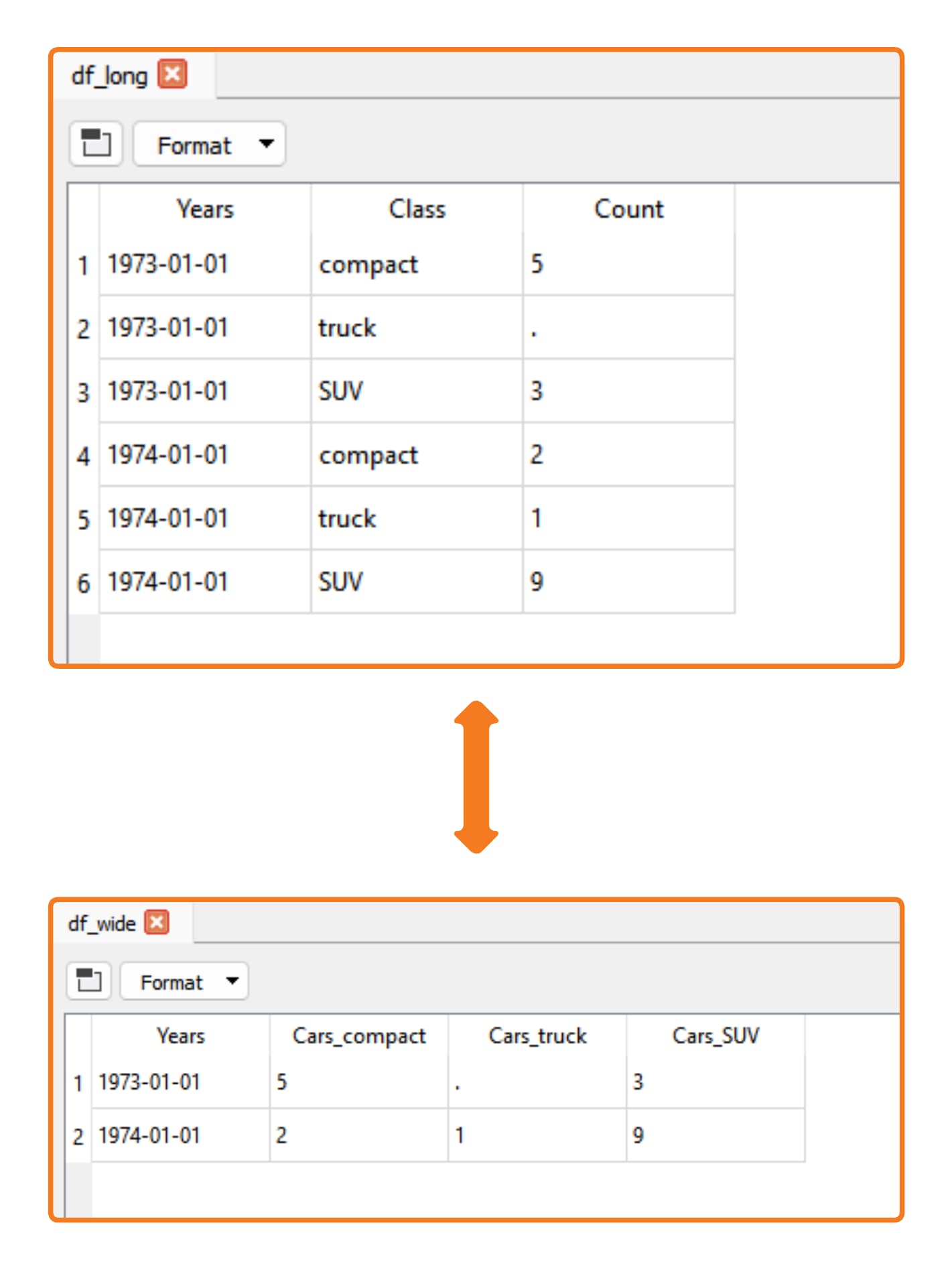Introduction
We're happy to announce the release of GAUSS 24, with new features for everything from everyday data management to refined statistical modeling.
GAUSS 24 features a robust suite of tools designed to elevate your research. With these advancements, GAUSS 24 continues our commitment to helping you conduct insightful analysis and achieve your goals.
New Panel Data Management Tools
GAUSS 24 makes working with panel data easier than ever. Effortlessly load, clean, and explore panel data without ever leaving GAUSS, making it the smoothest experience yet!
- Easily and intuitively pivot between long and wide form data with new dfLonger and dfWider functions.
- Explore group-level descriptive statistics and estimate group-level linear models with expanded
bykeyword functionality.
// Load data auto2 = loadd("auto2.dta"); // Print statistics table call dstatmt(auto2, "mpg + by(foreign)");
======================================================================= foreign: Domestic ----------------------------------------------------------------------- Variable Mean Std Dev Variance Minimum Maximum ----------------------------------------------------------------------- mpg 19.83 4.743 22.5 12 34 ======================================================================= foreign: Foreign ----------------------------------------------------------------------- Variable Mean Std Dev Variance Minimum Maximum ----------------------------------------------------------------------- mpg 24.77 6.611 43.71 14 41
Feasible GLS Estimation
// Load data df_returns = loadd("df_returns.gdat"); // Run FGLS with defaults AR(1) Innovations fgls(df_returns, "rcoe ~ rcpi";
Valid cases: 248 Dependent variable: rcpi
Total SS: 0.027 Degrees of freedom: 246
R-squared: 0.110 Rbar-squared: 0.107
Residual SS: 0.024 Std error of est: 0.010
F(1,246) 30.453 Probability of F: 0.000
Durbin-Watson 0.757
--------------------------------------------------------------------------------
Standard Prob
Variable Estimates Error t-value >|t| [95% Conf. Interval]
--------------------------------------------------------------------------------
Constant 0.0148 0.00122 12.1 0.000 0.0124 0.0172
rcoe 0.196 0.0685 2.86 0.005 0.0619 0.33
- Compute feasible GLS coefficients and associated standard errors, t-statistics, p-values, and confidence intervals.
- Provides model evaluation statistics including R-squared, F-stat, and the Durbin-Watson statistic.
- Choose from 7 built-in covariance estimation methods or provide your own covariance matrix.
Expanded Tabulation Capabilities
// Load data df = loadd("tips2.dta"); // Two-way table call tabulate(df, "sex ~ smoker");
============================================================
sex smoker Total
============================================================
No Yes
Female 55 33 88
Male 99 60 159
Total 154 93 247
============================================================
New tools for two-way tabulation provides a structured and systematic approach to understanding and drawing insights from categorical variables.
- New procedure tabulate for computing two-way tables with advanced options for excluding categories and formatting reports.
- Expanded functionality for the frequency function:
- New two-way tables.
- Sorted frequency reports and charts.
// Print sorted frequency table // of 'rep78' in 'auto2' dataframe frequency(auto2, "rep78", 1)
Label Count Total % Cum. %
Average 30 43.48 43.48
Good 18 26.09 69.57
Excellent 11 15.94 85.51
Fair 8 11.59 97.1
Poor 2 2.899 100
Total 69 100
Ready to elevate your research? Try GAUSS 24 today.
New Time and Date Extraction Tools
- 12 new procedures for extracting date and time components from dataframe dates.
- Extract date and time components ranging from seconds to years.
New Convenience Functions for Data Management and Exploration
- dropCategories - Drops observations of specific categories from a dataframe and updates the associated labels and key values .
- getCategories - Returns the category labels for a categorical variable.
- isString - Verify if an input is a string or string array.
- startsWith - Locates elements that start with a specified string.
- insertCols - Inserts one or more new columns into a matrix or dataframe at a specified location.
Improved Performance and Speed-ups
- Expanded functionality of strindx allows for searching of unique substrings across multiple variables.
- The upmat function now has the option to specify an offset from the main diagonal, the option to return only the upper triangular elements as a vector and is faster for medium and large matrices.
- Significant speed improvements when using combinate with large values of n.
- Remove missing values from large vectors more efficiently with speed increases in packr.
Conclusion
For a complete list of all GAUSS 24 offers please see the complete changelog.




